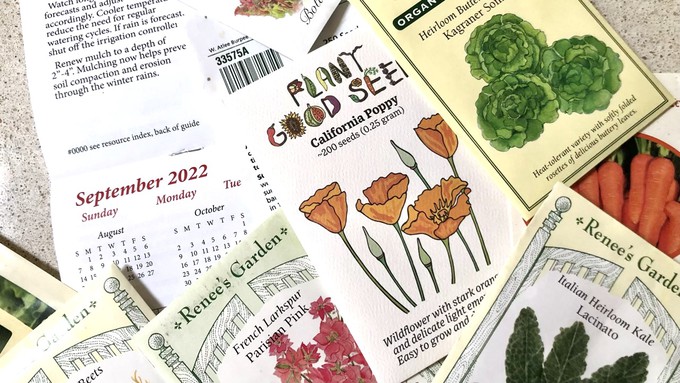
This weekend is too hot to plant -- but not to plan

Check your seeds and decide where and when the new plants will go in. Kathy Morrison
When do you plant a fall vegetable garden? It depends.
In Sacramento, Labor Day weekend traditionally marks that crossover from summer harvest to fall planting – but only after the tomatoes stop producing.
This summer, most of our tomatoes are already spent, victims of a very dry, very hot 2022. Those conditions put extra stress on plants. Heat-loving spider mites moved in and made themselves at home, sapping vines of energy.
For many tomato growers, the 2022 harvest was below par or nonexistent. Due to so many triple-digit days (35 and counting), tomato pollen dried up before it could fertilize flowers.
So, yeah, now is probably a good time to turn the page and pull the vines.
But when do you plant the fall veggies? Not quite yet, but soon. So, it's time to plan if not to plant.
With forecasts of record-high temperatures for this weekend, conditions are not good for setting out baby transplants; they’ll immediately be stressed. But as soon as the weather cools back to normal – mere 90s, not 100s – the fall seedlings can go in the ground. That could be next week.
Why plant cool-season crops when it’s still hot? Warm soil promotes rapid root development – a big plus for a good harvest in November, December and January.
Many cool-weather favorites – such as cabbages, head lettuce, broccoli and Brussels sprouts – take months to develop to maturity. Cabbage, for example, takes 60 to 100 days to form a solid head. Plant in September for Christmas cabbage.
Just not this weekend.
When it is cool enough to venture outside, prepare garden beds before transplanting. All those summer veggies sucked up a lot of nutrients. Cultivate and add compost to the soil. Let it rest a week or more before planting.
What to plant? In September, plant onions, lettuce, peas, radishes, turnips, beets, carrots, bok choy, spinach and potatoes directly into the vegetable beds.
Transplant cabbage, broccoli, kale, Brussels sprouts and cauliflower as well as lettuce seedlings. It’s not too late to start those seeds indoors and transplant in October or early November.
It’s a great time for flower planting, too. Sow seeds of California poppies, clarkia and African daisies. Also, transplant cool-weather annuals such as pansies, violas, fairy primroses, calendulas, stocks and snapdragons.
Whatever you plant, remember to water regularly. Seeds need even moisture to sprout. Avoid stressing new transplants by making sure soil doesn’t dry out.
And just like in summer, mulch works wonders, retaining soil moisture while cutting down on weeds. A new layer of mulch will help get those new seedlings off to a great start.
Comments
0 comments have been posted.Sacramento Digs Gardening to your inbox.
Sites We Like
Garden Checklist for week of Oct. 27
It's still great weather for gardening. Grab a sweater – and an umbrella, just in case – then get to work:
* October is the best month to plant trees, shrubs and perennials.
* Harvest pumpkins and winter squash.
* Pick apples and persimmons. Remember to pick up fallen fruit, too; it attracts pests.
* Clean up the summer vegetable garden and compost disease-free foliage.
* Dig up corms and tubers of gladioli, dahlias and tuberous begonias after the foliage dies. Clean and store in a cool, dry place.
* Treat azaleas, gardenias and camellias with chelated iron if leaves are yellowing between the veins.
* Now is the time to plant seeds for many flowers directly into the garden, including cornflower, nasturtium, nigella, poppy, portulaca, sweet pea and stock.
* Plant seeds for radishes, bok choy, mustard, spinach and peas.
* Plant garlic and onions.
* Set out cool-weather bedding plants, including calendula, pansy, snapdragon, primrose and viola.
* Reseed and feed the lawn. Work on bare spots.